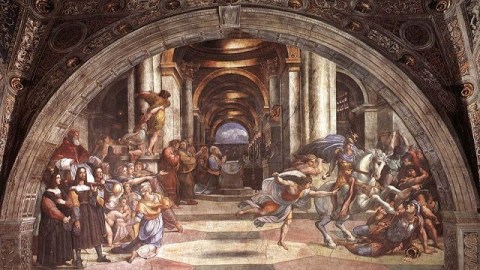How the Restored Raphael Frescoes Hang over Pope Benedict XVI’s Departure

When the College of Cardinals convenes next month in the Sistine Chapel to elect the successor to Pope Benedict XVI, Michelangelo’s majestic ceiling will hang over them while his Last Judgment passes silent judgment over their deliberations. But a different set of frescoes by a different Renaissance master also hang over the still-puzzling resignation of the pontiff. A conservation team recently completed the 30-year task of restoring Raphael’s Room of Heliodorus, so named for the fresco titled The Expulsion of Heliodorus from the Temple (shown above) and one of the private papal stanza. Pope Benedict XVI claims it is time for him to step down, but I doubt he timed his departure to coincide with the Raphael restoration’s completion. The coincidence, however, provides plenty of visual food for thought about the reign of the former Joseph Ratzinger and its enigmatic end.
Raphael began work on frescoes for the Room of Heliodorus and other papal stanza shortly after Michelangelo completed the ceiling frescoes for the Sistine Chapel. (You can take a virtual visit of the Room of Heliodorushere.) Legend holds that Raphael snuck into the chapel to peek at the frescoes and added a Michelangelo-esque portrait of Michelangelo himself to the near-complete School of Athens fresco in the Stanza della Segnatura, the first papal stanza Raphael began painting in. Michelangelo sits on the steps as a brooding Heraclitus in a bravura tribute from one master to another. Even if he didn’t continue to emulate Michelangelo’s brushwork style, Raphael continued to emulate Michelangelo’s new visual energy and humanist spirit. The frescoes of the Room of Heliodorus owe much to Michelangelo.
Sadly, Benedict XVI could have learned much from looking at and understanding the Renaissance artwork surrounding him every day of his papacy. The energy and humanism embedded in the imagery failed to impress on him a Pope John XXIII-esque appreciation for the world around him as being as much a creation of God as the world of the ancients. Even when Pope Benedict XVI broke down and joined the world of Twitter, he composed those tweets in Latin—an ironic failure to communicate with modern technology because of an attachment to a dead language and, perhaps, dead ideas. The Latin tweets eventually made their way into a variety of vulgate languages, but, as it always seemed the case with this pope, something—if not in meaning, at least in intent—was lost in translation.
The Room of Heliodorus hosted private audiences between the Pope and visiting diplomats. Therefore, Pope Julius II asked Raphael to work the theme of God’s protection of His church into the frescoes for the room. Now, when so many scandals threaten to dismantle the foundations of the Catholic Church, Raphael’s images of protection seem more relevant than ever before. The Pope (or at least Vatican officials) chose to put The Expulsion of Heliodorus from the Temple on the reverse of the 2011 Vatican 100 Euro Coin celebrating the seventh year of his papacy, so the image of a treasure protected by God’s action was present in his mind to some degree. What that “treasure” is and who God chooses to protect, however, might have been interpreted differently by Benedict.
The frescoes each show moments of miraculous rescue. The Map of Bolsena recounts an episode in 1263 when blood trickled from a consecrated host, thus divinely affirming the Catholic doctrine of transubstantiation—the moment when bread and wine become the body and blood of Christ. Angels bust the “first pope” out of prison in The Liberation of St. Peter. In The Encounter Between Leo the Great and Attila, the spirits of Saints Peter and Paul crash the real-life meeting between Pope Leo the Great and Attila the Hun in 452 AD and frighten “The Scourge of God” from invading Italy and ransacking Rome.
The room’s title fresco takes the theme of protecting treasure to a whole new level. Based on a story from 2 Maccabees, 3:21-28, The Expulsion of Heliodorus from the Temple shows a Syrian official named Heliodorus trying to claim the treasure of the Temple in Jerusalem for his boss, the Syrian King Seleucus IV Philopator. God answers the prayers of the priests and sends a heavenly horseman and two youths to thwart Heliodorus. From the far left side of the painting, Pope Julius II looks on the scene anachronistically. (Raphael inserted his own portrait on the far right wing of the work as a lasting “signature” and personal seal of approval.)
Imposing the theme of Heliodorus’ expulsion onto the present-day church begs the question of what the church’s “treasure” entails. Ask Benedict, and he might answer that the treasure lies in the long-held traditions and doctrines, which God protects through his representatives from the papacy down through the priesthood. Ask more forward-thinking Catholics, and they might answer that the treasure lies in the body of the Church, the people around the globe who trust in the goodness of the institution and feel betrayed not just by the various scandals, but also by the relentless and often heartless cover-up and often outright denial of those scandals’ existence. Is Benedict the protector in the painting? Or is his stepping down God’s way of protecting the church from Benedict and the fortifications against the future and transparency he built and reinforced to the end of his reign? Who’s the angel and who’s Heliodorus? The restoration of this fresco raises questions of interpretation as fresh as today but as ancient as the Old Testament.
The name Heliodorus means in Greek “Gift of the Sun.” Perhaps Pope Benedict XVI’s stepping down and the restoration of the Heliodorus frescoes are God’s “gift” of sunlight illuminating the real treasure of the church, which can be a vital and relevant part of the modern world, given the opportunity. If the College of Cardinals grow weary of staring at Michelangelos, maybe they should take a short walk and muse on these Raphaels and glean the lessons they hold.
[Image:Raphael. The Expulsion of Heliodorus from the Temple (pre-restoration), 1512-1514. Image source.]





